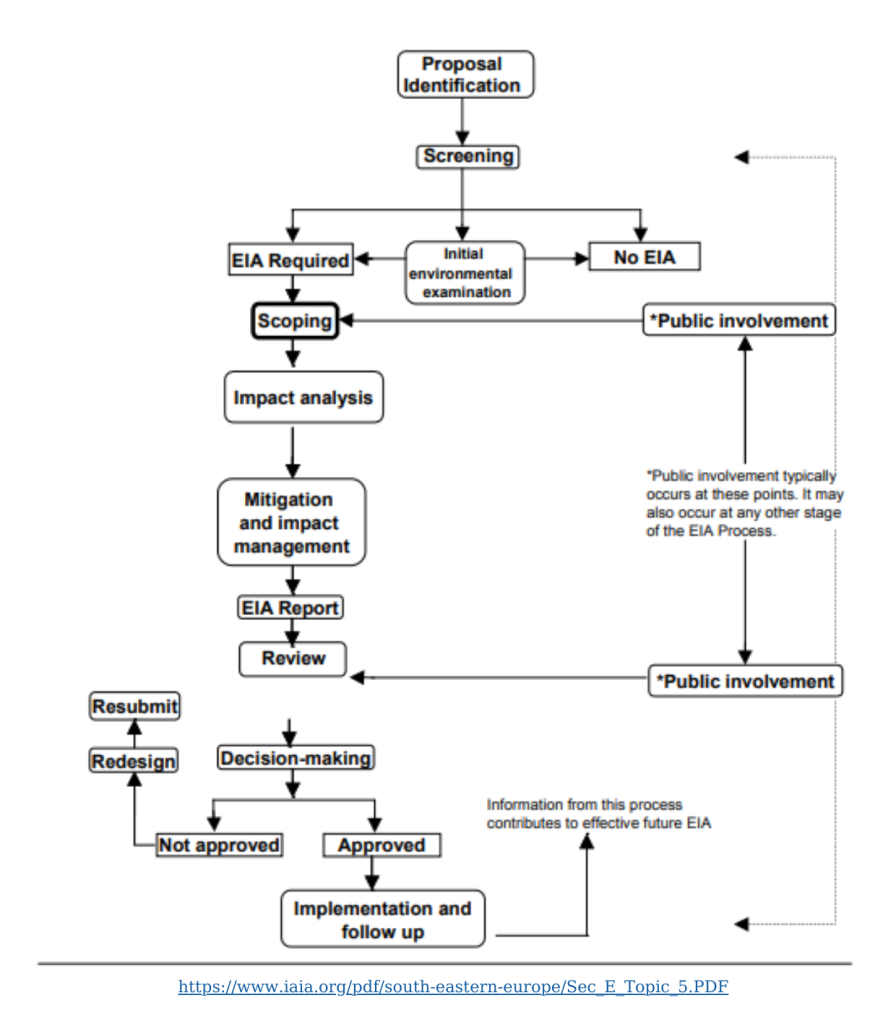We have heard about the EIA processes that generally include screening, scoping, reporting, approval, and implementation. In this brief, we will focus on the screening and scoping stages of the EIA process.
Screening is the first step of the EIA process and it is used to determine whether EIA is required or not. It is intended to ensure that any EIA review is proportional to the potential environmental impacts of the proposed project. In some countries, the project developers need to obtain what they referred to as a screening opinion from the relevant authority which is a statement that an EIA should be submitted for the current or future project proposal. The screening opinion will identify the environmental factors that need to be considered in EIA, and it may also cover other aspects of the EIA process.
The requirement for screening and the procedure to be followed is often defined in the applicable EIA law or regulations. In many cases, the projects to which EIA applies are listed in an annex and the screening could be done simply by following this project list. However, it should be noted that project lists are specific to a particular country or jurisdiction and so adequate review by relevant and competent stakeholders is important. If necessary, the project list should be revised and updated over time through a consultative process among relevant stakeholders.
Under certain circumstances, a relatively small project proposal might have potentially adverse environmental impacts. In this case, the screening can be done by following any indicative guideline or using certain criteria relevant to any legal requirements. The criteria might be developed and agreed upon among relevant stakeholders that might include a range of aspects, such as the project’s location or proximity to any designated protected area or special heritage landscape; the existing land uses and obligations within it; or the relative abundance, quality, regenerative capacity, and absorption capacity of the natural environment.
Once the screening confirms that an EIA is required, it is also important to define how the EIA and other studies will be incorporated into the different steps. There are some points to be considered here such as:
- To ensure complementarities and to avoid overlap between the EIA and other studies, especially if they are not prepared by the same expert.
- To ensure that the studies are based on sufficient technical information and assessment of realistic options so that they could influence the selection of project alternatives and the final project design.
- To ensure that the costs of impact reduction, adaptation measures, residual environmental externalities, and costs associated with potential climate change risks are being considered.
Screening establishes the basis for scoping which is another stage that refers to the early, open, and interactive process of determining the major issues and impacts that need to be addressed in an EIA. Key objectives of scoping are to:
- inform the public about the proposal;
- identify the main stakeholders and their concerns and values;
- define the reasonable and practical alternatives to the proposal;
- focus on the important issues and significant impacts to be addressed in the EIA;
- define the boundaries for an EIA in time, space, and subject matter;
- set requirements for the collection of baseline and other information; and
- establish the Term of Reference (TOR) for an EIA study.
The steps in the scoping process include:
- preparing and developing the outline through informal consultation with relevant stakeholders;
- creating a long list of the range of issues and concerns and evaluating their relative importance and significance to derive a short list of key issues;
- organizing the key issues into the impact categories to be studied;
- establishing the TOR for the EIA; and
- monitoring the progress against the TOR, making adjustments as needed, and providing feedback to stakeholders and the public.
The TOR as the final product from the scoping study can refer to some or all of the following items:
- purpose and application of the TOR;
- statement of need for and objectives of the proposal; project background and description;
- study area or impact zones;
- applicable policy and institutional considerations;
- EIA requirements and decision-making particulars;
- provisions for public involvement;
- alternatives to be examined;
- the impacts and issues to be studied;
- the studies to be carried out;
- the requirements for mitigation and monitoring;
- the information and data to be included in the EIA report;
- the timeframe for completion of the EIA process; and
- the means for making changes to the TOR if necessary.
It is important to have a good understanding of any application of EIA law or regulations within certain administrative areas or jurisdictions accompanied by technical rigor and a thorough consultative process among relevant stakeholders for doing the screening and scoping.
Hope this brief could enlighten some of us about the screening and scoping as part of the EIA process.
References:
- Duck, S.H., Environmental Impact Assessment Report Scoping Report, July 2020, retrieved online from:
https://epawebapp.epa.ie/licences/lic_eDMS/090151b280769388.pdf - EIA screening: changes and challenges, IEMA, retrieved online from:
https://www.iema.net/articles/eia-screening-changes-and-challenges - EIA Training Resource Manual: Topic 4 – Screening, 2nd edition 2002, International Association of Impact Assessment (IAIA), retrieved online from:
https://www.iaia.org/pdf/south-eastern-europe/Sec_E_Topic_4.PDF - EIA Training Resource Manual: Topic 5 – Scoping, 2nd edition 2002, International Association of Impact Assessment (IAIA), retrieved online from:
https://www.iaia.org/pdf/south-eastern-europe/Sec_E_Topic_5.PDF - Guidance on EIA-screening, European Commission, retrieved online from:
https://ec.europa.eu/environment/archives/eia/eia-guidelines/g-screening-full-text.pdf - Guidance on EIA-scoping, European Commission, retrieved online from:
https://ec.europa.eu/environment/archives/eia/eia-guidelines/g-scoping-full-text.pdf - SCOPING and EIA, retrieved online from:
https://www.eia.org.za/the-process/scoping-and-eia/ - Terms of reference for an Environmental Impact Assessment, retrieved online from:
https://europa.eu/capacity4dev/file/29941/download?token=crbpG2yd
By: Hendra WINASTU, SOLEN Principal Associate – IPC panel coordinator
Edited by: Moe Thazin Shwe, SOLEN Research Associate – IPC panel member
Date: 26 April 2023
Article#: SOLEN-IPC-0016



 Tiếng Việt
Tiếng Việt 日本語
日本語
Pingback: How do we do the Environmental Impact Assessment (EIA)? - Solen
Pingback: Term of Reference for EIA - Solen